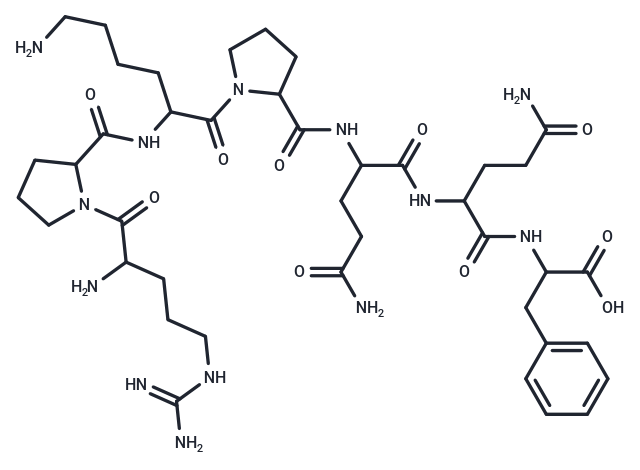Shopping Cart
- Remove All
 Your shopping cart is currently empty
Your shopping cart is currently empty

Substance P(1-7) (Substance P 1-7) is the major bioactive metabolite formed after proteolytic degradation of the tachykinin substance P (SP),with anti-inflammatory, anti-nociceptive and anti-hyperalgesic effects

| Pack Size | Price | Availability | Quantity |
|---|---|---|---|
| 2 mg | $70 | Backorder | |
| 5 mg | $98 | Backorder | |
| 10 mg | $160 | Backorder | |
| 25 mg | $288 | Backorder | |
| 50 mg | $432 | Backorder | |
| 100 mg | $648 | Backorder |
| Description | Substance P(1-7) (Substance P 1-7) is the major bioactive metabolite formed after proteolytic degradation of the tachykinin substance P (SP),with anti-inflammatory, anti-nociceptive and anti-hyperalgesic effects |
| In vivo | Substance P 1-7, SP(1-7), which is the main SP fragment in rat CNS, was injected intranigrally. SP(1-7) was found to act as a very potent antagonist against the SP-induced responses and was formed locally in the nigra after SP injection. It is proposed that SP(1-7) is an endogenous modulator of SP actions. Generation of peptide fragments, which retain receptor affinity but not efficacy, may be a general mechanism for autoregulation in peptidergic systems[1]. |
| Alias | Substance P 1-7 |
| Molecular Weight | 900.04 |
| Formula | C41H65N13O10 |
| Cas No. | 68060-49-1 |
| Relative Density. | 1.49 g/cm3 (Predicted) |
| Storage | keep away from moisture | Powder: -20°C for 3 years | In solvent: -80°C for 1 year | Shipping with blue ice. |

Copyright © 2015-2025 TargetMol Chemicals Inc. All Rights Reserved.